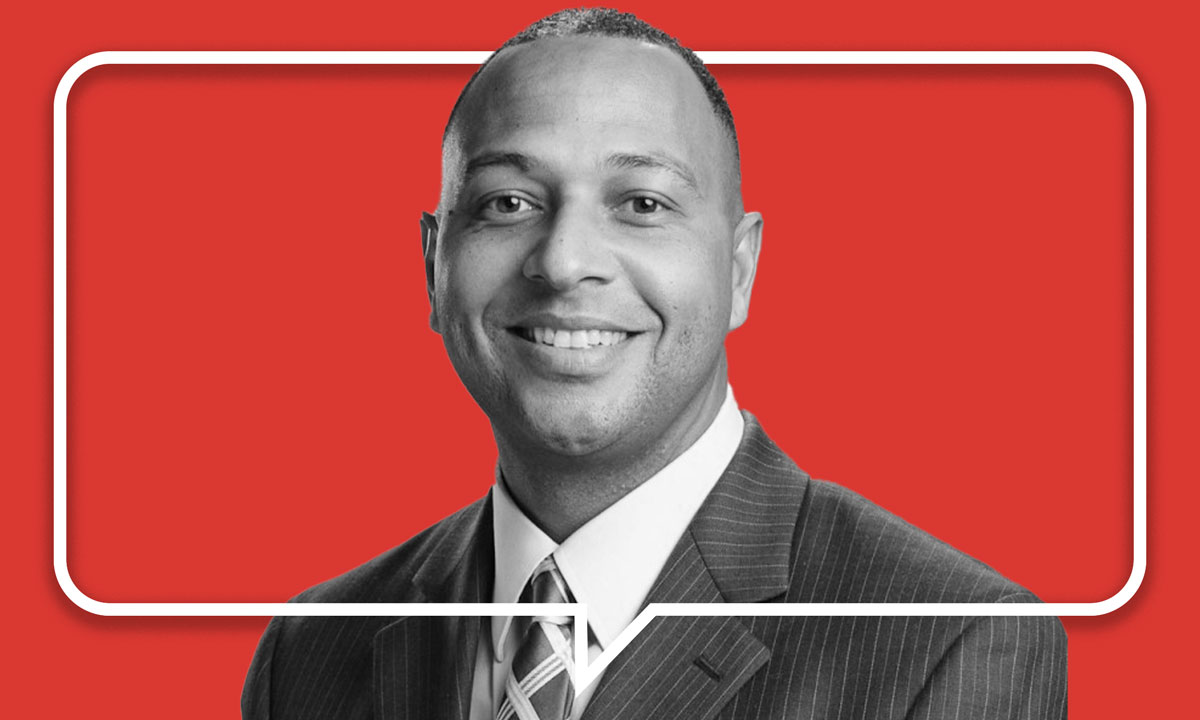On Katrina’s 20th Anniversary, Patrick Dobard Revisits NOLA Reboot
Former head of the Recovery School District talks reform, race and work yet undone in turning around New Orleans' schools.

Get stories like this delivered straight to your inbox. Sign up for The 74 Newsletter
This is part of a series covering the 20th anniversary of Hurricane Katrina, its effects, and the recovery of New Orleans’ schools. Read all our coverage and essays here.
Over the last two decades, countless individuals have played roles — ranging from the literal raking of muck to the refining of reading instruction — in remaking New Orleans’ public schools. Many arrived as young, mostly white do-gooders from other parts of the country, eager to work brutal hours to revive schools in a storied city.
As the largest school improvement effort in U.S. history matured, so did the energetic transplants. Wanting kids of their own and more sustainable jobs, many moved back home, bringing their experiences to bear in classrooms in places where life is easier.
Patrick Dobard has been there the whole time. He was born in New Orleans, grew up in the city and cut his teeth there as a teacher. In the years before Hurricane Katrina, he worked for the Louisiana Department of Education, trying to figure out how to address the decay of New Orleans’ schools — beloved but crumbling, scandal-ridden and some of the lowest-performing in the country.
In 2012, Dobard became head of the Recovery School District, the state agency that took control of most of the city’s public schools in the wake of the flood and steered their overhaul. There, he oversaw the district’s conversion to the nation’s first all-charter school system, as well as the return of the schools to the control of the local school board starting in 2016.
In 2017, he became CEO of New Schools for New Orleans, the district’s nonprofit partner. Today, he is a partner at the City Fund, which helps districts engineer their own school turnarounds.
What follows is a conversation in which Dobard reflects on the first two decades of the largest — and most controversial — school improvement effort in U.S. history, and outlines his hopes for the next 20 years.
This interview has been edited for length and clarity.
Among education wonks, discussions about public education in New Orleans can feel like a Rorschach Test. Some people are laser-focused on academics, some on policy innovations that might transfer to other school systems and still others on privatization conspiracy theories. Locally, though, one of the most enduring conversations involves popular perceptions of a takeover of a Black-led school system by white outsiders who valued test scores more than the city’s culture. This is true — but also not the capital-T truth. Can we start there?
I started as a classroom teacher in New Orleans in 1989 at Gregory High School, which was a junior high school, grades 7 through 9, located in what at the time was a pretty middle- to upper-middle-class neighborhood, Gentilly. Most high schools then started at 10th grade. Junior highs were extremely important as athletic and band pipelines.
The workforce for the most part at Gregory represented how the workforce across the city’s schools looked at that time: predominantly Black middle- to upper-middle-class individuals teaching kids.
The schools that had really stringent enrollment criteria, like what was then named Lusher [now the Willow School] and Ben Franklin High School, more white students went to those schools. They had majority white staff.
By 1999, the state had created an accountability system under which a large number of the schools in the city — I believe about 60% — were identified as academically unacceptable. At that point, I was working at the state Department of Education.
There was a lot of corruption in the air in New Orleans. There were conversations about the district being bankrupt. There was a Federal Bureau of Investigations [probe] going on.
In 2003, the state created an agency called the Recovery School District. In the spring of 2005, the initial plan was for it to take over about three schools in New Orleans. We didn’t really know what that was going to look like. But then Katrina hit Aug. 29, 2005, and all those plans were put on hold.
We were getting phone calls weeks and months after Katrina from teachers trying to get a hold of their teaching certificates so they could work other places. There was just mass displacement of teachers.
And that’s where I think people’s knowledge of what happened gets told in different ways. The district was bankrupt. There wasn’t a way for it to pay teachers, so it was forced to lay them off. The state didn’t step in to try to offset that. So it was the district that had to fire the teachers and not the state.
People were setting up the modular trailers and all the things people did after Katrina to get their lives back on track. There were schools — mostly the selective-enrollment schools that I mentioned earlier — where people were able to come back a little bit more quickly. Those schools were bringing teachers back and hiring.
The Recovery School District was trying to recruit back New Orleans teachers, but a lot of the Black middle class didn’t have the ability or the wherewithal to come back to New Orleans those first few years.
Once the state decided that they were going to try the chartering model, the RSD started to recruit from Teach For America. A large number of TFA folks from all around the country wanted to come help. A number of those individuals were white. They didn’t look like the kids that ultimately were in front of them in schools.
I have no inside knowledge of this, but I don’t think TFA leadership at that time had lots of conversations strategically thinking about race. They were just functioning the way they normally functioned.
Data shows having kids in front of teachers that are really strong and that look like them helps make for much better educational progress for young people. Once John White came in [as state superintendent in 2012], we were hearing a lot about the lack of diversity in the teaching force.
John and I talked to TFA leadership about diversifying. While the number of Blacks and other minorities in TFA increased, it didn’t match the number of teachers of color that were there before the storm.
Seven or eight years ago, I brought that awareness to the teacher work that we were doing at New Schools for New Orleans [where Dobard was then CEO]. We wanted to help schools build a corps of teachers that reflected the kids in the classrooms. Schools just took that on. They owned up to where they fell short, and then they actively recruited to make sure those numbers improved.
I don’t think anyone had intentional ill will. It was a series of unfortunate circumstances that folks were reacting to after Katrina: the bankruptcy of the district and the uncertainty of people coming back to the city at different times, which was skewed to more white and affluent Blacks coming more quickly than others.
And yet the narrative persists.
Yeah, the narrative persists. I think what’s been missing is no one from the Orleans Parish School Board who was part of the decision to lay off the teachers to my knowledge has ever publicly acknowledged the firings. Or apologized for having to do that. Or for what transpired in the years before 2005, with the FBI having to be there and how bad it was.
There’s no closure. There should be a moment of healing. The times that the district leadership over the years was approached, nobody really wanted to acknowledge it that way. Some felt like it was on the state for not stepping in. So maybe the state leadership at that time should apologize.
It feels like in terms of the school governance experiment, you’re at an inflection point. There’s continued improvement, but there are also tensions over whether an accountability-driven system is still something the community is lined up behind.
I think the governance contract is working well. Around 2016, I was leading the work on behalf of the Recovery School District. School leaders and advocates like the Urban League, New Schools for New Orleans and a number of other groups were working together on what the unification structure would look like. A number of legislators at the time helped to codify in law the governance construct that was created over the years as Act 91.
It’s no longer an experiment. It’s really how schools function in New Orleans. The district has fully embraced it, maintained it and actually improved upon it. It’s a different role than any other school board in the country, but it’s also an extremely important one that’s proven to have spurred tremendous gains.
Yes, there are some people who would like to see the district go back to the way it functioned prior to Katrina. But I don’t think those individuals are but a small minority who are for the most part consistent and persistent in their viewpoint.
“That’s the one do-over I wish I had: To know that 20 years was not going to be enough time.
Patrick Dobard
That arguably 40 years may not be enough time.”
When things are working well in New Orleans, you don’t hear from people. Nobody’s going to say, “Hey, the governance structure of this school that my kids have been at for the last 15 years and my grandchildren have gone through is great.” When I was state superintendent, I used to ask kids and parents, “Do you know if this school is run by the Recovery School District or by Orleans Parish?” And they’d just look at me, like, “No.”
The average citizen, what they want to know is, is my child getting a good education? Do we have good extracurricular activities? Does the transportation work well?
I’ll tell you one quick story. Dana Peterson, who now is the CEO of New Schools for New Orleans, was involved in some sessions with parents. He had this parent who was just railing against charter schools. Like, “We need to go back to what was before.”
Dana was like, “Do you realize your kid’s in a charter school?” The parent was at a loss. She was happy with where her child was, but she was indoctrinated that charter schools are bad. I think for some of the critics, that’s what it is.
If you don’t really know what the governance construct is, at the end of the day it’s all about who’s working with the kids. There’s more proximity when it’s a charter network, with the urge to improve all the time so they can continue to have the privilege to teach kids. Versus a bureaucracy that’s expected to do it but that doesn’t have strong accountability to make sure it’s not year-after-year failure.
And that’s what it was before 2005.
Reams have been written about the rapid academic improvements, the all-charter model and, more recently, the racial upheaval. What about the fact that you had to rebuild — as in, rebuild the buildings — 85% of the schools?
Prior to Katrina, the buildings said to our kids and families, “We don’t care about you.” Those dilapidated buildings are no longer there. That’s something worth celebrating.
Being a young boy that grew up in New Orleans, I’m extremely proud of the facilities. The price tag came to a little over $4 billion, if I’m remembering correctly. About a billion came from the disadvantaged business enterprise program that we started at the Recovery School District.
My first months as superintendent, there was an article in The Times-Picayune where they followed me as I rode the bus the first day of school with some kids to see what their experience was. I met the kids across the street from Dooky Chase’s Restaurant on Orleans Avenue.
I was talking to the kids and a mom, and I pointed to Dooky Chase and right behind Dooky Chase there was a school. It was [what is now] Phyllis Wheatley Community School. There was a debate whether or not to rebuild it.
I said, “We’re going to rebuild this school right here. And if we did, would you have your kid come here?” She’s like, “Absolutely I would.” We demolished the building and built new.
I’m extremely proud of that because my father was a part-time electrician and I could remember when I was a young boy, him getting work with one of his friends who was a subcontractor on large jobs. As I got older, I understood how important it was to be able to have subcontractors that were often minorities to work on large construction projects.
When I took over the RSD, New Orleans didn’t have a disadvantaged business program. And once I realized what that was, I felt it was important that we try to implement one. I was told that state agencies couldn’t have a DBE component.
But we had legal take a look into it, and they advised me that the law was silent. It didn’t say whether you could or you couldn’t. I felt like it was important for us to at least try. And if we were challenged in court, we would see what a judge would say.
Once we launched it, I received maybe one or two emails from, like, the carpenters union saying we couldn’t do that. But they never followed up. We generated over $10 billion of revenue for local businesses and I’m extremely proud of that.
To this day, every now and then if I look at the placards on the front of a school I see my name and those of the folks on my team that helped make that happen. It brings me a great sense of pride and joy to know we played a small part in making sure that we have facilities where, when children and families walk in, they say to themselves, “This district really cares about me.”
Do you have a wish for the next 20 years?
I wish that we continue to build upon the foundation that’s been laid. I would love for us to eliminate all D-rated schools, to have a true system of good-to-excellent schools.
That we would have a much more robust early childhood system where 5-year-olds and 6-year-olds are entering kindergarten and first grade on grade level. Today, we still have kids that enter all grades not reading on grade level, so schools have to keep almost starting over with kids.
The last thing that I would hope for is that the school board in New Orleans more vocally embrace the structure that’s been created. To be unambiguous about its power in being a manager of a system of schools, versus being a traditional school district. That they fully understand and embrace that role and lead the way on that evolution.
If you had a do-over, what would you change?
I would have intentionally built the next generation of leadership to think more about the system as a whole and to prepare for inevitable transitions — everything that we did 15 or so years ago. We had this rare confluence of strong leadership at almost every level: the schools, the state.
We leveraged everything in our power. For every metric evaluated by external entities, the growth was really powerful. We virtually eliminated F-rated schools. The on-time graduation rate is hovering close to about 80%. It was about 54% around 2005.
I wish we would have started to build that next cadre of leadership in real time. But it’s hard to be in the midst of something so unique and try to think 15, 20 years ahead. I was literally trying to think eight hours, one week, one month ahead. Things were just always coming at us, and we were constantly building and adjusting.
We get these great leaders, and they do great work — almost like a meteorite or something that comes and then goes away just as quickly. People move on.
The work is so hard. This is generational work.
Disclosure: The City Fund provides financial support to The 74.
Get stories like these delivered straight to your inbox. Sign up for The 74 Newsletter

;)
